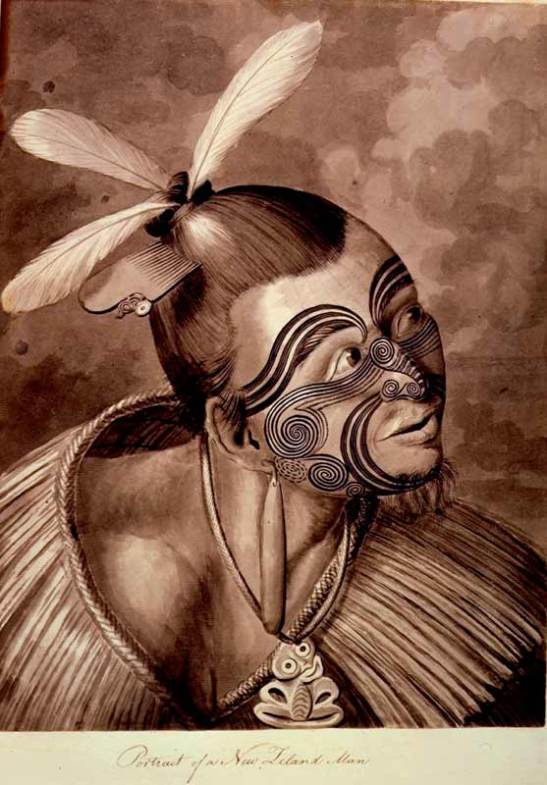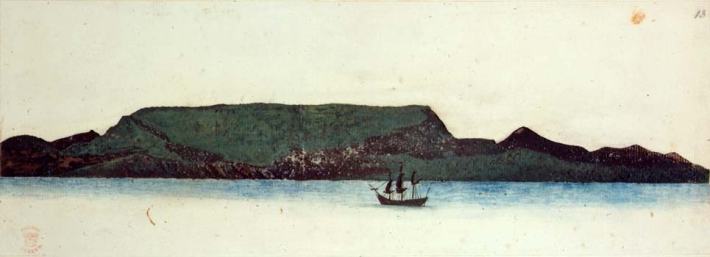For the blog assignment for the Classical Era, our job was to construct three artists whom were connected by a similar theme; the theme for which I chose was how art in the 1700’s was inspired by scientific discovery and invention. For this I will use examples from the artists Sydney Parkinson, Alexander Buchan, and George Frideric Handel.
This piece above is titled “Portrait of a New Zealand man” by Sydney Parkinson created in October 1769, created in New Zealand. Sydney Parkinson was on Captan Cooks first voyage to the South Pacific leaving in 1768. Parkinson was inspired by science simply by where he was on Captain Cooks ship which was on a mission of Scientific discovery of the Terra Australis Incognita or “unknown southern land”. Not only would this voyage inspired by science and discovery inspire Parkinson and put him in a place to create such work, but the voyage in itself would shape mankind and help to create new sciences, for instance possibly laying the pathway for Charles Darwin’s voyage.
The next individual on the list of Classical artists inspired by science is George Frideric Handel. The German turned British composure was inspired by science, to show this look no farther than his work “Minuet“ which was created in 1747 in the city of London. Click on the link to listen to the work, now the question in lies how was Handel inspired or his work somehow shaped by science? Well, by 1700 Bartolomeo Cristofori an Italian music maker had invented the Piano. This invention laid the way for Handel to create his work, such as the link “Minuet”, on the piano.
Last but not lest is the artist Alexander Buchan, whom was also on Captain James Cook’s first voyage, but unlike Sydney Parkinson, Buchan died on the voyage and was buried at sea. Like Parkinson though, Buchan was influenced by science on what he encountered on this scientific voyage to the south-land.
The Painting above is that of of Buchan’s titled “View of the coast of Tierra del Fuego,” created on the coast of New Zealand in January 1769. The painting illustrates the ship of Captain Cook and the landscape of the land which they had just discovered, pioneering new settlements and other new discoveries.
Work Cited:
“George Frideric Handel.” Wikipedia. N.p., 25 Feb 2013. Web. 5 Mar 2013. <http://en.wikipedia.org/wiki/George_Frideric_Handel
“Sydney Parkinson.” Wikipedia. N.p., 27 Feb 2013. Web. 5 Mar 2013. <http://en.wikipedia.org/wiki/Sydney_Parkinson>.
“Bartolomeo Cristofori.” Wikipedia. N.p., 04 Mar 2013. Web. 5 Mar 2013. <http://en.wikipedia.org/wiki/Bartolomeo_Cristofori>.
“Piano.” Wikipedia. N.p., 03 Mar 2013. Web. 5 Mar 2013. <http://en.wikipedia.org/wiki/Piano>.
“First voyage of James Cook.” Wikipedia. N.p., 27 Feb 2013. Web. 5 Mar 2013. <http://en.wikipedia.org/wiki/First_voyage_of_James_Cook>.
“Alexander Buchan.” Wikipedia. N.p., 04 Jun 2012. Web. 5 Mar 2013. <http://en.wikipedia.org/wiki/Alexander_Buchan_(artist)>.
Buchan, Alexander. View of the coast of Tierra del Fuego. 1769. British Library, London.
Parkinson, Sydney. Portrait of a New Zealand man. 1769. British Library, London.
Handel, George Frideric. “Minuet”. 1747. London. <http://www.youtube.com/watch?v=H4KTpHW0ZP4>
“Captain Cook Timeline.” Timeline. N.p.. Web. 5 Mar 2013. <http://www.captcook-ne.co.uk/ccne/timeline/voyage1.htm>.


Very interesting piece of history. Nice work on citing your sources. The music was wonderful to listen to as well.